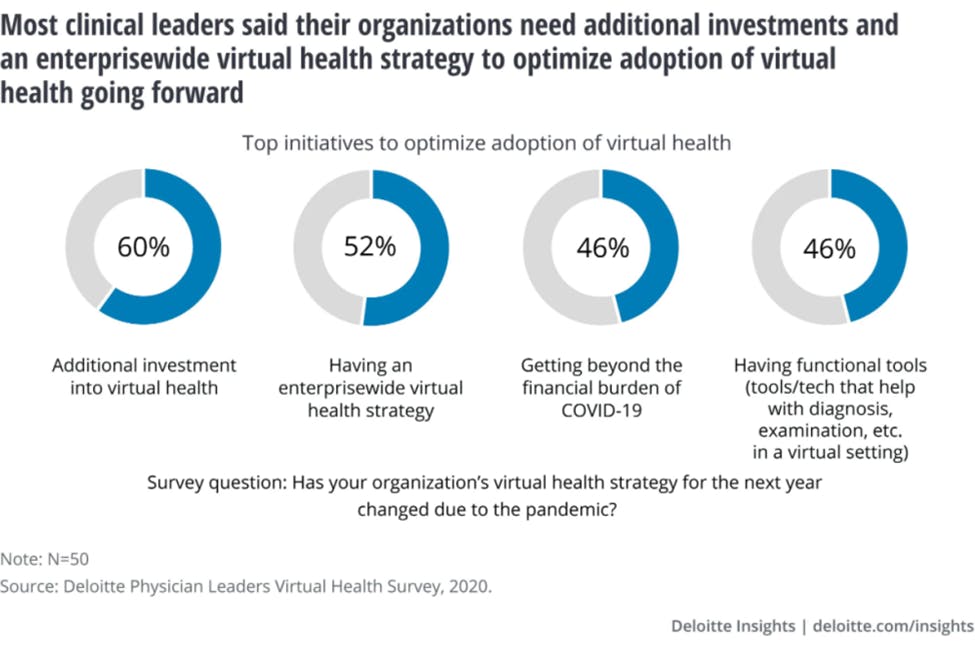The healthcare industry is undergoing massive changes and most of this evolution is being stimulated by transformation and technology. Health systems and hospitals are working to reduce the burden on healthcare providers while improving care for patients.
The shift in The Healthcare Industry
Virtual health and home care became not only an essential but a preferred mode post-pandemic. However, the transition was not as abrupt as it appears. Several developments such as shifting consumer preferences, rapidly evolving technologies, and clinical innovation have been in progress for a long time. These trends forced healthcare systems to adopt digital technology as the center of their transformation strategy.
Virtual health entails at-a-distance interactions to advance patient care and well-being in a linked, synchronized manner—all while continuing to evolve a more humanized healthcare system. The ability to remotely share data, drive content, and personalize interactions enriches provider-patient interactions while meeting consumer healthcare expectations.
As consumers take greater control of their health-related decisions, healthcare organizations are aligning technology investments to build a user-centric approach. An approach where digital investments improve patient experiences and deliver modern forms of care.
Prevailing Trends in Healthcare
Increased adoption and investment in virtual visits

According to Deloitte’s physician leader virtual health survey, virtual visits constitute one-third of primary care and chronic care management visits in the United States. These leaders suggested additional investment and enterprise-wide virtual health strategy adoption.
Telehealth and Videoconferencing Consultation
According to Elsevier’s Clinician of the Future 2022 report, clinicians expect most consultations to be remote in 10 years, delivered via telemedicine and virtual appointments. Telehealth and video consultation seek to make healthcare services more accessible to patients, allowing them to avoid visits to the doctor's office. This way patients can get care whenever they want.
Electronic Patient Records (EPRs)
For accurate, comprehensive, and updated patient medical records across the industry, healthcare organizations adopted the concept of EPR/EMR/EHR. The industry-wide EHR switch enabled patients to get more involved in communication with physicians and their health decisions.
While many of the leading EHRs are looking for ways to provide support on a variety of end-point devices there is still a significant need for standardization, central management, and a homogeneous platform to access data irrespective of the device or operating system, along with a reliable layer of Zero Trust security.
Agile and Resilient Applications
The Healthcare Internet of Things (H-IOT) aids early diagnosis and better care by connecting every active object in the healthcare world. These objects can interact with one another and make decisions to a certain extent and can range from a wearable device (attached to a patient's body) on one side of the spectrum to a data server of the healthcare provider on another.
On the other hand, these applications could be most suited to deploy either within the hospital premise or on a choice of public cloud. The technology is expected to abstract the layer of all these moving parts while providing a simple and consistent platform for clinicians to be productive irrespective of location or device.
Vulnerability to Cyber Attacks
As more healthcare centers adopt mandated EHR and more EHRs are recorded on cloud-based servers, the chances of data breaches from cyber-attacks grow dramatically. Healthcare was always one of the most targeted industries for cybercriminals well before the transition to EHRs.
Now that the transition is becoming the norm, with volumes of confidential and valuable data stored in the cloud, cybersecurity is more important than ever. Multi-form factor devices, different device lifecycles, and roaming requirements make devices prone to cyber-attacks. According to a March 2022 survey, one-third of medical practices have experienced a data breach, of which 49% were the result of human error.
Paving A Technical Path for Healthcare
While these trends in technology are changing the aspects of how the healthcare industry functions, proven solutions such as LibreSpace, powered by Citrix, can help you sustain and improve your modern healthcare experience.
High Performance
- Consistent and reliable functioning
- Optimized video conferencing tools
- Meeting the IT needs of all users across all environments
Mission-critical Support
- Personalized cloud-based desktop for secure remote access
- Elements to enable faster access and information sharing
- Securely enabling work on any device and network at any time
Security at Every Step
- Securely handling sensitive clinical data and managing audit trails for regulatory compliance
- Watermarking, session recording, actionable analytics, MFA, and adaptive security for different contextual needs
- Comprehensive AI- and ML-based security analytics that monitors all activities and adapts security controls to mitigate inside threat or breach
Supporting Healthcare IT Requirements
- Secure access to EHR from any device
- Real-time access to high graphics reports such as radiology and scanning
- Handling disparate legacy apps
- Reducing technology worries for clinicians so they can spend more time with patients
Final Word
Librespace, powered by Citrix, offers an apt response to modern challenges in the healthcare industry. Together, we’re actively working to provide increased accessibility to health data and clinical decision support at the point of service. And enabling a unified experience for the healthcare providers to seamlessly support patients.
Our consolidated offering ensures end-to-end IT infrastructure support, from facilitating virtual healthcare services to proactively managing and protecting critical EHR.
Digital healthcare era - enabling patient care via modern workplace technology
References
- Digital transformation in healthcare | Deloitte Insights
- https://www.elsevier.com/connect/clinician-of-the-future
- us-lshc-realizing-the-potential-of-telehealth.pdf (deloitte.com)
- Videoconferencing for telehealth: Unexpected challenges and unprecedented opportunities | British Columbia Medical Journal (bcmj.org)
- Electronic Health Records – Current Trends in EHR and Beyond (ebi.edu)
- Electronic Patient Record - an overview | ScienceDirect Topics
- https://www.softwareadvice.com/resources/healthcare-data-security-report/



